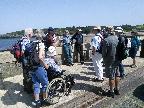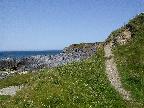Cemaes Bay
 On Friday, 28th June,14 geology group members met in Cemaes Bay car park at 10.30 am for a prompt 11 am start. A £3 fee was collected, the disclaimer form signed and contact numbers noted. Checks were made that sensible shoes were worn. Lenses handed out and 2 members given the first aid kits to carry.
On Friday, 28th June,14 geology group members met in Cemaes Bay car park at 10.30 am for a prompt 11 am start. A £3 fee was collected, the disclaimer form signed and contact numbers noted. Checks were made that sensible shoes were worn. Lenses handed out and 2 members given the first aid kits to carry.
 Our GeoMôn guide, Andy Short who is an excellent guide and took us around Rhoscolyn last year was introduced to members who hadn't met him before. I gave him his £50 fee before the start of the trip. (£8 from the ' kitty ') The more members that attend the less we have to pay.
Our GeoMôn guide, Andy Short who is an excellent guide and took us around Rhoscolyn last year was introduced to members who hadn't met him before. I gave him his £50 fee before the start of the trip. (£8 from the ' kitty ') The more members that attend the less we have to pay.
Andy began by explaining what we would see & encounter walking up headlands, uneven steps, rough routes down to quarries etc. I followed this by a H&S talk. Anyone feeling they couldn't manage any part of the trip to let Andy/myself know. It was the hottest day of the year and the steps different heights. During the 1 pm picnic I felt extremely ill, (most embarrassing) I asked Heather Williams to take over my position as back marker and left the group. On the beach where we picnicked was the grey-blue Precambrian limestone, a large cave in the limestone where iron ore was mined and the remains of an derelict lime kiln on the path down.
 Our trip took us along tracks, beaches and headlands. Andy pointed out the Precambrian Melange. 650 MY.
Our trip took us along tracks, beaches and headlands. Andy pointed out the Precambrian Melange. 650 MY.
(Mélange in this case means a jumble of rocks) Very old and can be seen around Cemaes Bay, Llanbadrig and Llanddwyn Island. These rocks contain some of the oldest fossils ever found. Stromatolites. These are single celled algae which club together forming large flat mats. Each cell absorbs carbon dioxide and expels oxygen. This increased the amount of oxygen in the atmosphere over million & millions of years. Dr. Margaret Wood who has guided us on field trips was the first person to discover the stromatolites in Anglesey and wrote a geological paper on the subject. Edward Greenly, 1919 was the geologist who discovered the Mélange.
All this information on the forming of the mélange can be found on Google. It covers plate tectonics, subduction of oceanic plates scraping off rocks from the above plate. Plates traveling down into the mantle, heat & pressure transforming one rock into something else. (mud, sandstone & limestone turned into what we see today.)
There is a white quartzite rock that was under pressure & heat but not hot enough to turn it into quartz. Andy pointed out intrusive Palaeozoic dykes 450 MY formed through fissures in the rock.
I missed the afternoon but the visit continued around Llanbadrig bay seeking out the stromatolite fossil. Once again an excellent guided trip by Andy.
I try to write my reports so that any member can get a good grasp of geology. Stromatolites are still found today in Australia and information can be found on Google.
Next trip, a guided tour around Cefn Mawr Quarry.
Isabel.
Back to Geology group page
